Abstract
It has been reported that trypan blue treatment decreases the nonspecific resistance of mice to transplanted tumors and inhibits the in vitro cytotoxic activity of activated macrophages. We wished to determine whether this effect of trypan blue could be due to a selective inhibition of certain macrophage functions or whether it reflected a broader form of immunosuppression. We therefore tested the effects of trypan blue on a variety of immunological responses. Treatment of mice with trypan blue delayed their rejection of skin allografts and transplants of a highly antigenic syngeneic ultraviolet light-induced tumor. Trypan blue treatment of either donor or recipient decreased the local graft-versus-host reaction. Filtration of lymph node cells from trypan blue-treated donors on a nylon wool column before use in the graft-versus-host assay abrogated the depressive effect of trypan blue. A transient reduction in the blastogenic response of spleen cells to concanavalin A and lipopolysaccharide mitogens was observed after a single injection of trypan blue, but the response of lymph node cells was unaffected. The depressed response of splenic lymphocytes was not entirely reversed by removal of adherent cells. The primary and secondary hemagglutinin responses to sheep erythrocytes were unaffected in trypan blue-treated mice, and the proportion and phagocytic activity of thioglycolate-induced peritoneal macrophages were also unaltered. We conclude that treatment of mice with trypan blue selectively inhibits certain macrophage functions but, at high doses, it can also inhibit some lymphocyte activities.
Full text
PDF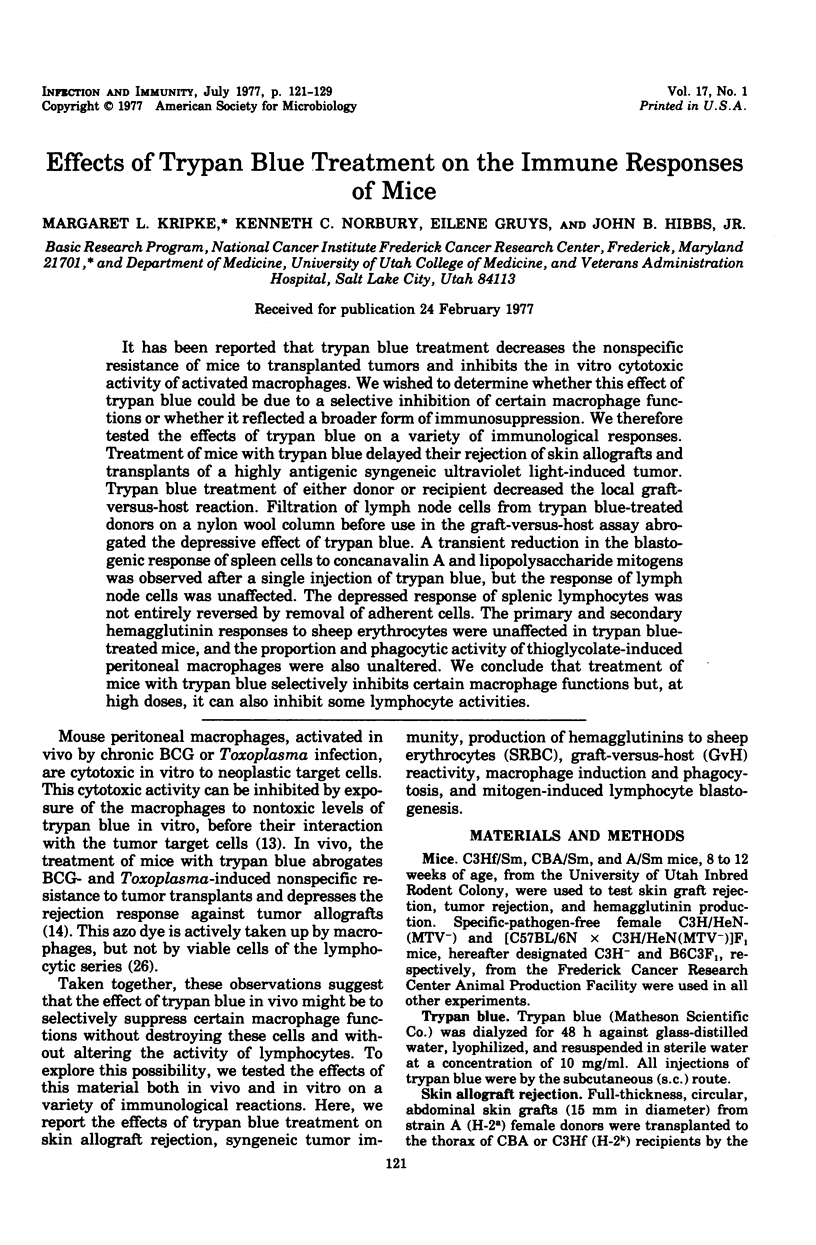
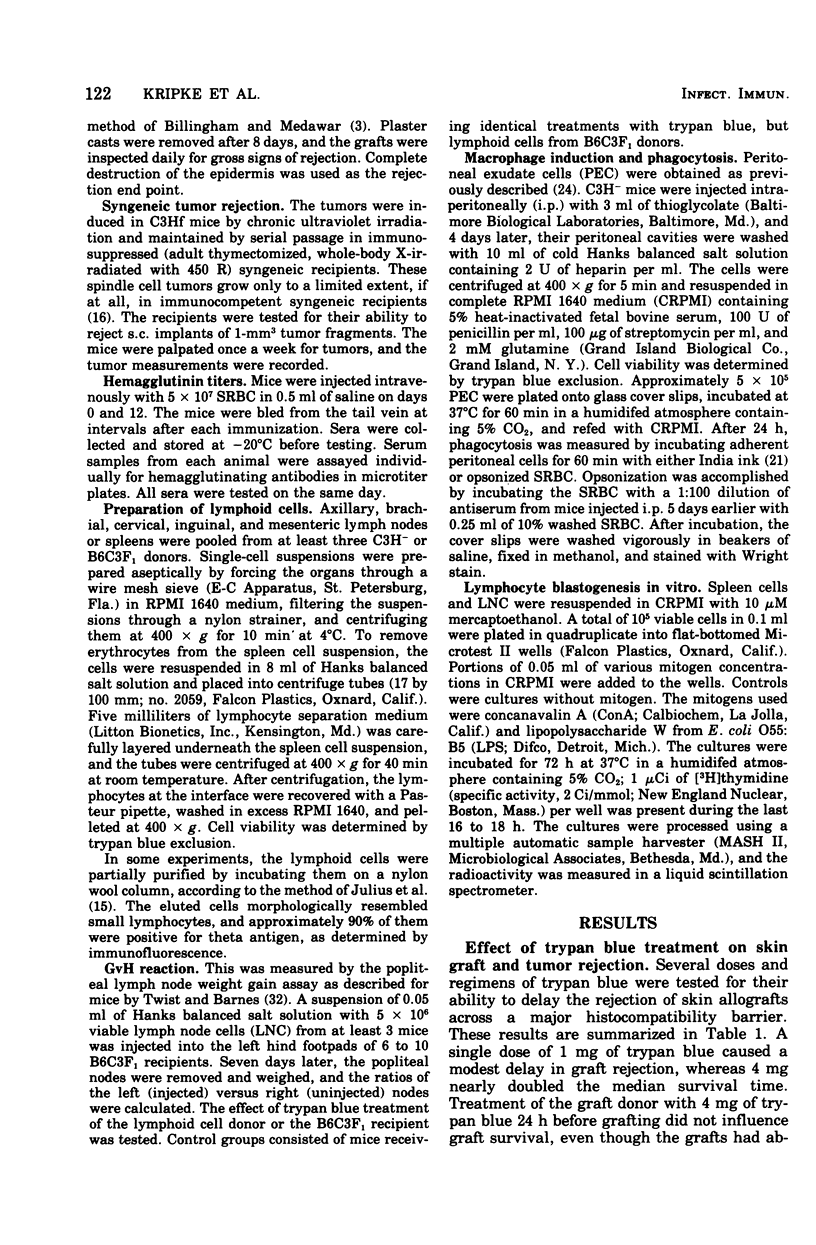
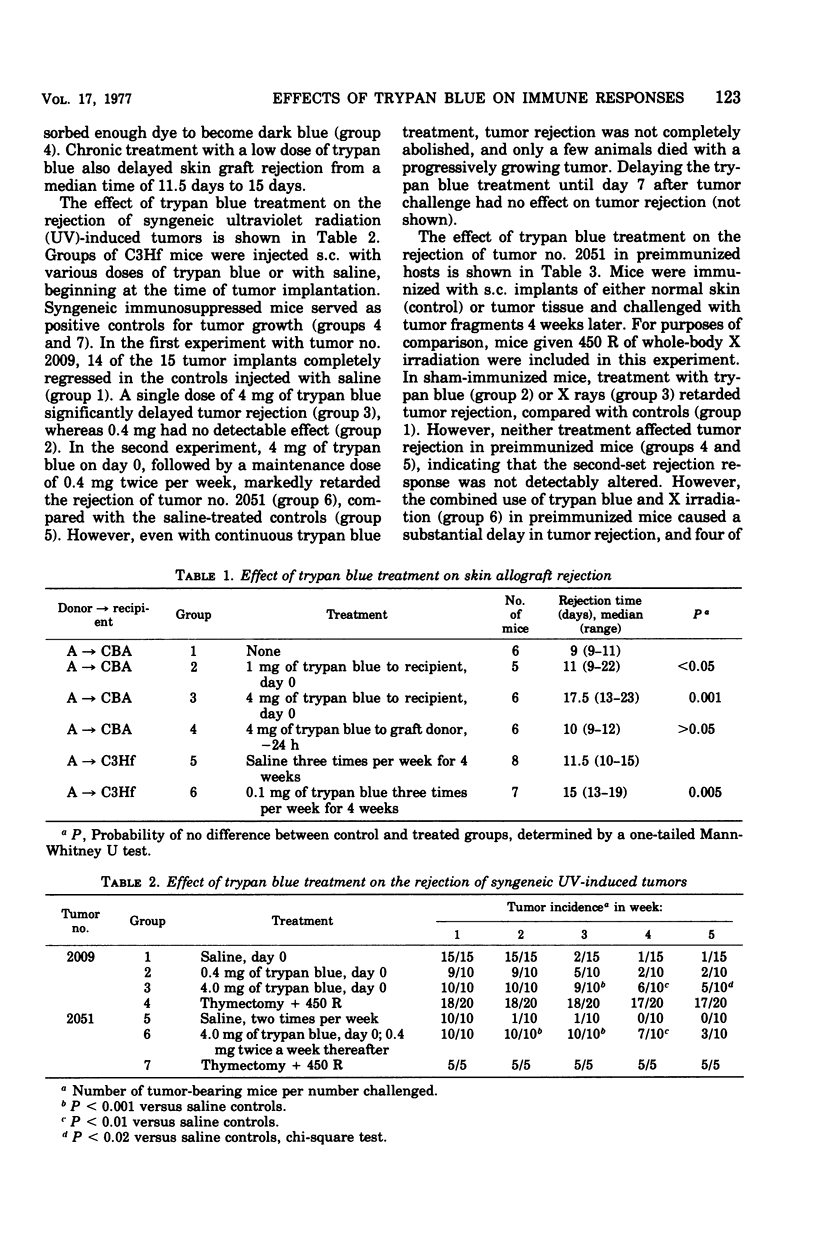
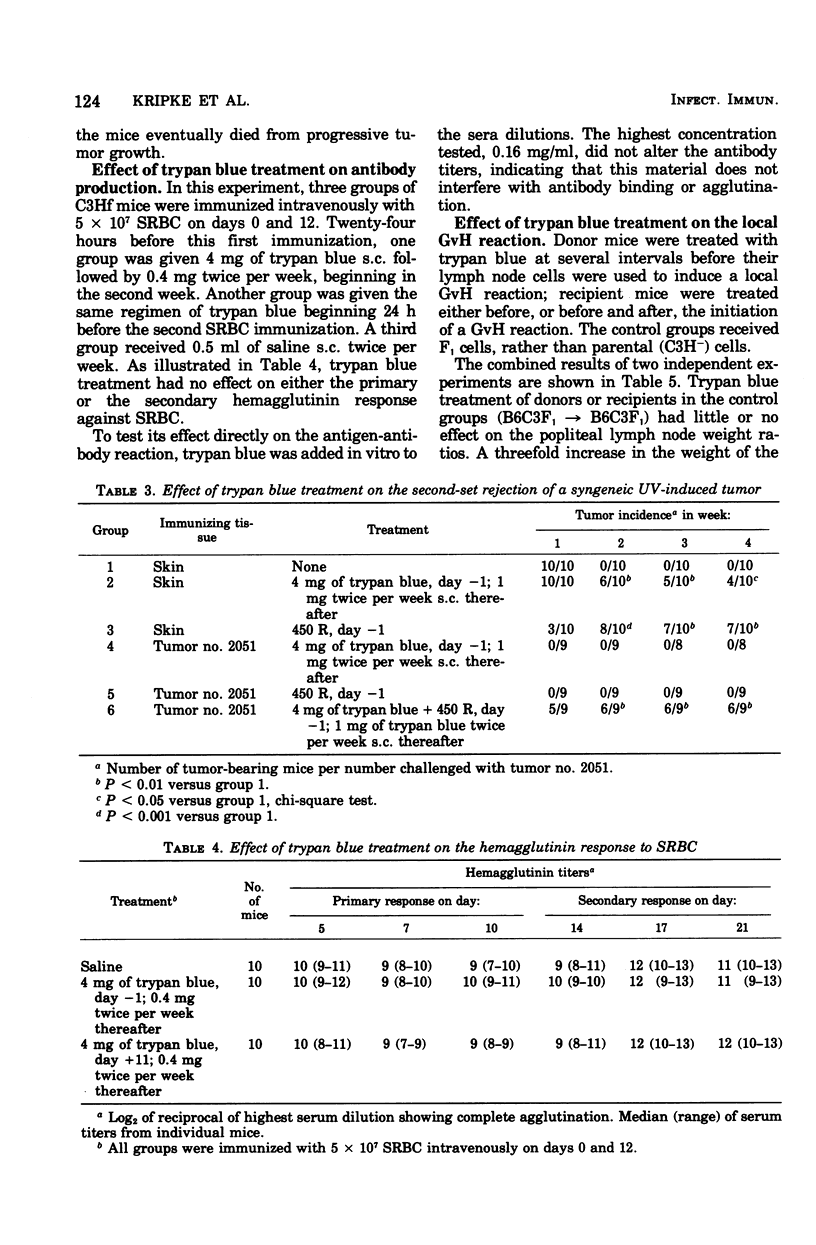
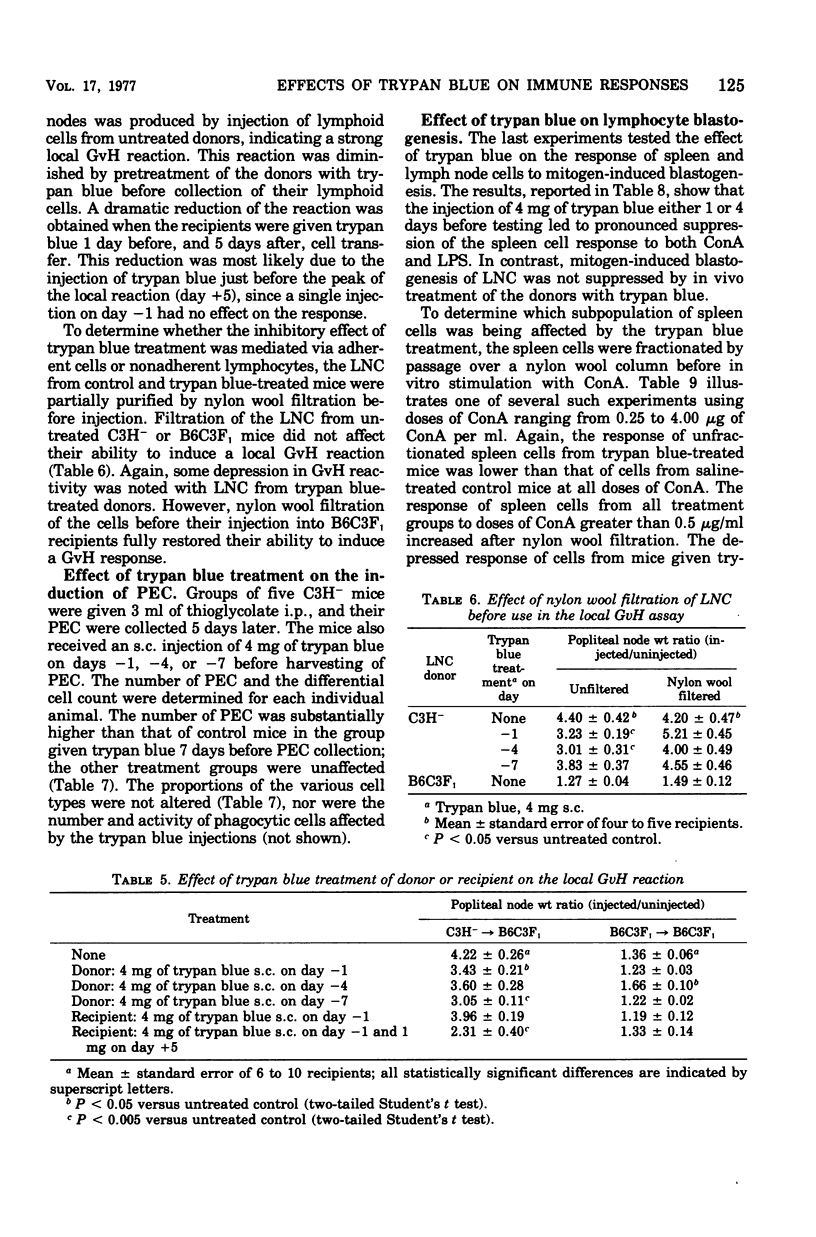
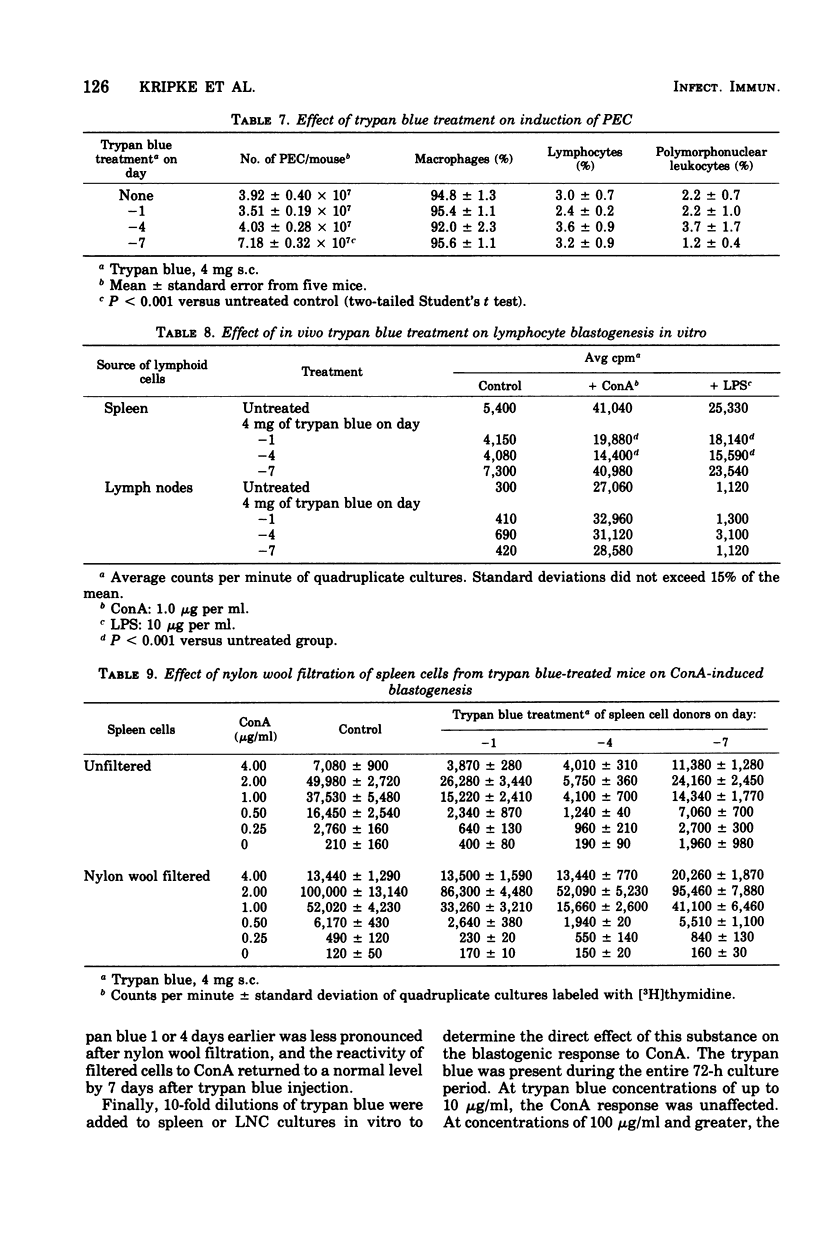


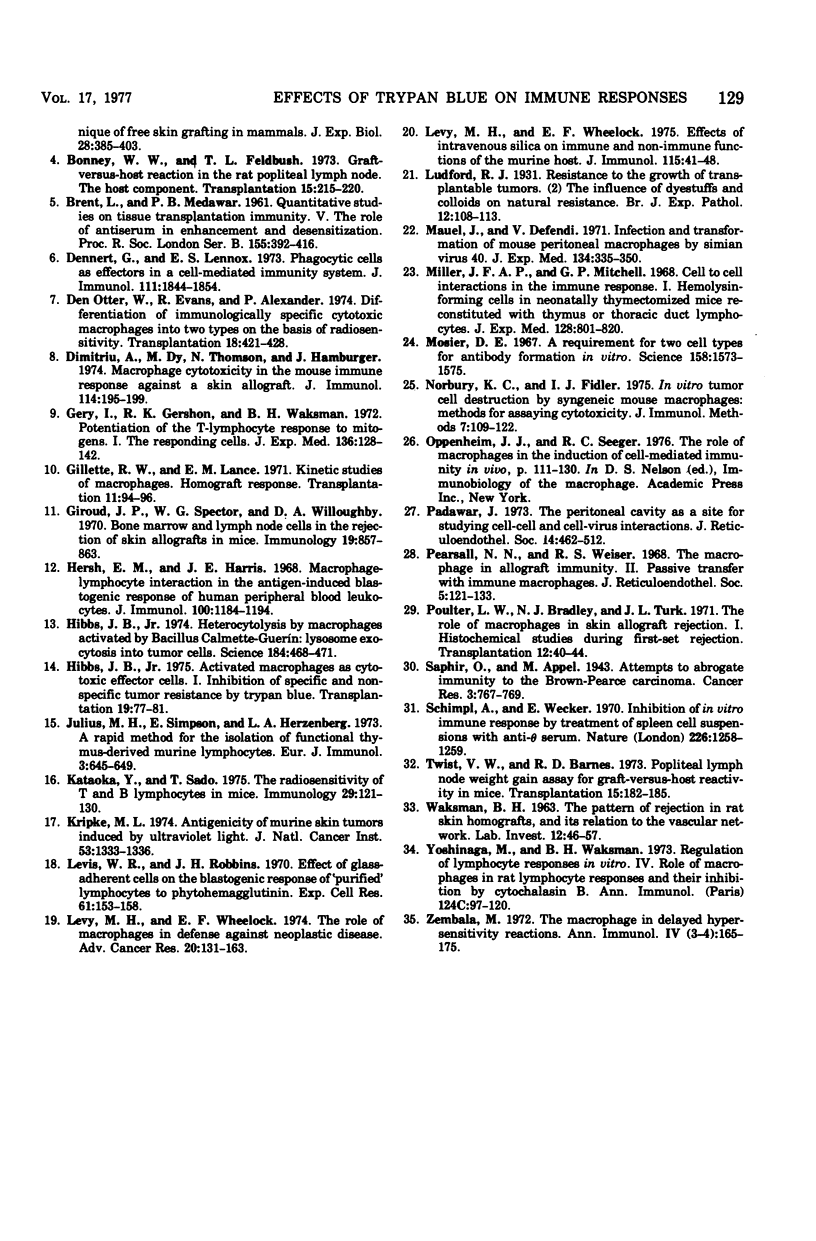
Selected References
These references are in PubMed. This may not be the complete list of references from this article.
- Argyris B. The role of macrophages, thymus- and bone marrow-derived cells in the graft-versus-host reaction. Transplantation. 1974 Apr;17(4):387–391. doi: 10.1097/00007890-197404000-00008. [DOI] [PubMed] [Google Scholar]
- Bonney W. W., Feldbush T. L. Graft-versus-host reaction in the rat popliteal lymph node. Transplantation. 1973 Feb;15(2):215–220. doi: 10.1097/00007890-197302000-00005. [DOI] [PubMed] [Google Scholar]
- Den Otter W., Evans R., Alexander P. Differentiation of immunologically specific cytotoxic macrophages into two types on the basis of radiosensitivity. Transplantation. 1974 Nov;18(5):421–428. doi: 10.1097/00007890-197411000-00006. [DOI] [PubMed] [Google Scholar]
- Dennert G., Lennox E. S. Phagocytic cells as effectors in a cell-mediated immunity system. J Immunol. 1973 Dec;111(6):1844–1854. [PubMed] [Google Scholar]
- Dimitriu A., Dy M., Thomson N., Hamburger J. Macrophage cytotoxicity in the mouse immune response against a skin allograft. J Immunol. 1975 Jan;114(1 Pt 1):195–199. [PubMed] [Google Scholar]
- Gery I., Gershon R. K., Waksman B. H. Potentiation of the T-lymphocyte response to mitogens. I. The responding cell. J Exp Med. 1972 Jul 1;136(1):128–142. doi: 10.1084/jem.136.1.128. [DOI] [PMC free article] [PubMed] [Google Scholar]
- Gillette R. W., Lance E. M. Kinetic studies of macrophages. Homograft response. Transplantation. 1971 Jan;11(1):94–96. doi: 10.1097/00007890-197101000-00015. [DOI] [PubMed] [Google Scholar]
- Giroud J. P., Spector W. G., Willoughby D. A. Bone marrow and lymph node cells in the rejection of skin allografts in mice. Immunology. 1970 Dec;19(6):857–863. [PMC free article] [PubMed] [Google Scholar]
- Hersh E. M., Harris J. E. Macrophage-lymphocyte interaction in the antigen-induced blastogenic response of human peripheral blood leukocytes. J Immunol. 1968 Jun;100(6):1184–1194. [PubMed] [Google Scholar]
- Hibbs J. B., Jr Activated macrophages as cytotoxic effector cells. Transplantation. 1975 Jan;19(1):77–81. doi: 10.1097/00007890-197501000-00015. [DOI] [PubMed] [Google Scholar]
- Hibbs J. B., Jr Heterocytolysis by macrophages activated by bacillus Calmette-Guérin: lysosome exocytosis into tumor cells. Science. 1974 Apr 26;184(4135):468–471. doi: 10.1126/science.184.4135.468. [DOI] [PubMed] [Google Scholar]
- Julius M. H., Simpson E., Herzenberg L. A. A rapid method for the isolation of functional thymus-derived murine lymphocytes. Eur J Immunol. 1973 Oct;3(10):645–649. doi: 10.1002/eji.1830031011. [DOI] [PubMed] [Google Scholar]
- Kataoka Y., Sado T. The radiosensitivity of T and B lymphocytes in mice. Immunology. 1975 Jul;29(1):121–130. [PMC free article] [PubMed] [Google Scholar]
- Kripke M. L. Antigenicity of murine skin tumors induced by ultraviolet light. J Natl Cancer Inst. 1974 Nov;53(5):1333–1336. doi: 10.1093/jnci/53.5.1333. [DOI] [PubMed] [Google Scholar]
- Levis W. R., Robbins J. H. Effect of glass-adherent cells on the blastogenic response of 'purified' lymphocytes to phytohemagglutinin. Exp Cell Res. 1970 Jul;61(1):153–158. doi: 10.1016/0014-4827(70)90269-7. [DOI] [PubMed] [Google Scholar]
- Levy M. H., Wheelock E. F. Effects of intravenous silica on immune and non-immune functions of the murine host. J Immunol. 1975 Jul;115(1):41–48. [PubMed] [Google Scholar]
- Levy M. H., Wheelock E. F. The role of macrophages in defense against neoplastic disease. Adv Cancer Res. 1974;20:131–163. doi: 10.1016/s0065-230x(08)60110-4. [DOI] [PubMed] [Google Scholar]
- Mauel J., Defendi V. Infection and transformation of mouse peritoneal macrophages by simian virus 40. J Exp Med. 1971 Aug 1;134(2):335–350. doi: 10.1084/jem.134.2.335. [DOI] [PMC free article] [PubMed] [Google Scholar]
- Miller J. F., Mitchell G. F. Cell to cell interaction in the immune response. I. Hemolysin-forming cells in neonatally thymectomized mice reconstituted with thymus or thoracic duct lymphocytes. J Exp Med. 1968 Oct 1;128(4):801–820. doi: 10.1084/jem.128.4.801. [DOI] [PMC free article] [PubMed] [Google Scholar]
- Mosier D. E. A requirement for two cell types for antibody formation in vitro. Science. 1967 Dec 22;158(3808):1573–1575. doi: 10.1126/science.158.3808.1573. [DOI] [PubMed] [Google Scholar]
- Norbury K. C., Fidler I. J. In vitro tumor cell destruction by syngeneic mouse macrophoages: methods for assaying cytotoxicity. J Immunol Methods. 1975 Apr;7(1):109–122. doi: 10.1016/0022-1759(75)90136-2. [DOI] [PubMed] [Google Scholar]
- Padawer J. The peritoneal cavity as a site for studying cell-cell and cell-virus interactions. J Reticuloendothel Soc. 1973 Nov;14(5):462–512. [PubMed] [Google Scholar]
- Pearsall N. N., Weiser R. S. The macrophage in allograft immunity. II. Passive transfer with immune macrophages. J Reticuloendothel Soc. 1968 Apr;5(2):121–133. [PubMed] [Google Scholar]
- Poulter L. W., Bradley N. J., Turk J. L. The role of macrophages in skin allograft rejection. I. Histochemical studies during first-set rejection. Transplantation. 1971 Jul;12(1):40–44. doi: 10.1097/00007890-197107000-00006. [DOI] [PubMed] [Google Scholar]
- Schimpl A., Wecker E. Inhibition of in vitro immune response by treatment of spleen cell suspensions with anti-theta serum. Nature. 1970 Jun 27;226(5252):1258–1259. doi: 10.1038/2261258a0. [DOI] [PubMed] [Google Scholar]
- Twist V. W., Barnes R. D. Popliteal lymph node weight gain assay for graft-versus-host reactivity in mice. Transplantation. 1973 Jan;15(1):182–185. doi: 10.1097/00007890-197301000-00028. [DOI] [PubMed] [Google Scholar]
- WAKSMAN B. H. The pattern of rejection in rat skin homografts, and its relation to the vascular network. Lab Invest. 1963 Jan;12:46–57. [PubMed] [Google Scholar]
- Yoshinaga M., Waksman B. H. Regulations of lymphocyte responses in vitro. IV. Role of macrophages in rat lymphocyte responses and their inhibition by cytochalasin B. Ann Immunol (Paris) 1973 Feb;124(1):97–120. [PubMed] [Google Scholar]


